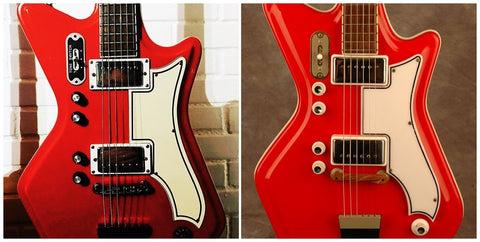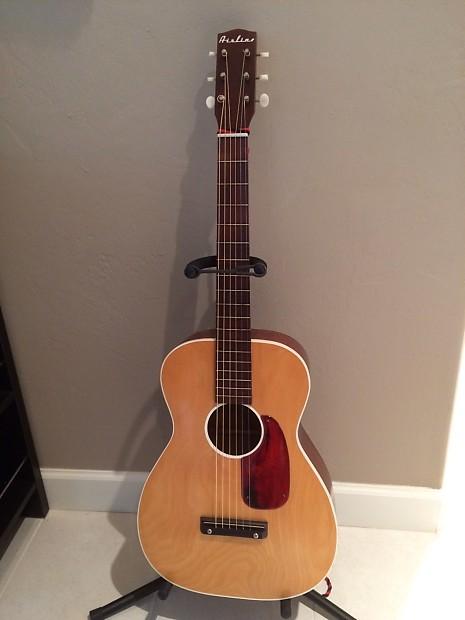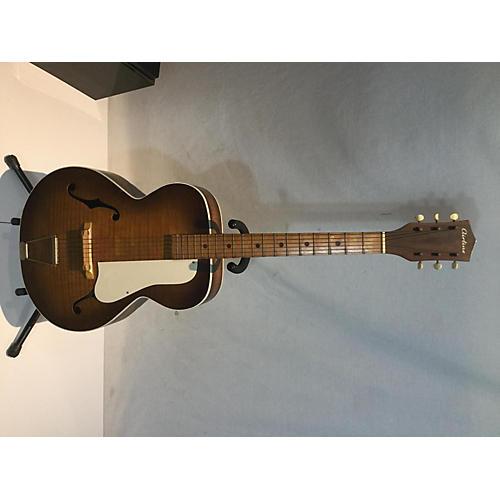If I told you that a seemingly ordinary guitar could transport you back in time, wrapping you in the warm, nostalgic melodies of the past yet resonating perfectly with the contemporary riffs of today, you might raise an eyebrow. Well, truth is stranger than fiction when it comes to the Airline acoustic guitar. It’s not just a musical instrument; it’s a time machine.
In my experiences as a seasoned luthier, and a chronic aficionado of vintage stringed instruments, very few have captured my attention and admiration quite like these. What intrigues me, you ask? Their genuine allure is a combination of historical appeal, unique tonality, and distinct aesthetic – a trifecta that isn’t easily found.
Imagine holding a piece of history in your hands, its body whispering tales from the golden era of music. Yes, this is the vintage Airline guitar for you – an auditory chronicle that reverberates with the songs of yesteryears. Each one tells a different story, their distinct scars evidently marking their immense value. But how do you understand and evaluate this value? It’s a journey that requires a discerning eye, a patient heart, and an understanding of what truly makes these instruments unique.
In my quest to demystify the allure of Airline acoustic guitars, we’ll delve deep into the heart of their features, guide you on where to find authentic editions and teach you the art of navigating the sometimes-turbulent waters of travelling with such an instrument – all while appreciating their charming, sentimental value.
So, are you ready for a melodic journey through time? Let’s uncover the vibrant stories of these vintage wonders, the Airline acoustic guitars. You’re about to discover the sweetest notes hidden in their simple, rustic chords.
History of Airline Guitars

As someone deeply invested in the rich lineage of stringed instruments, I invite you to share in the discovery of this relatively unknown episode in American guitar history. This exploration is not centered on massive guitar factories or the well-known powerhouses such as Fender and Gibson. Instead, we delve into the story of a brand that might seem importantly commonplace: Airline Guitars.
Let’s take a step back, perhaps to an era that many of us might not have witnessed firsthand. Amidst our technological era, it may be unusual to think of department store chains as purveyors of musical instruments. Nevertheless, some of the most fascinating tales of retail magic unfurl in these unexpected avenues. And in perhaps none is this more true than the story of Montgomery Ward, an iconic American department store chain, and the beloved Airline Guitar.
Did you know that the origins of Airline guitars are tied with a renowned department store chain? Prepare for a journey through time as we uncover their story. It’s an exemplary narrative of innovation meeting commerce, relevant to all guitar enthusiasts scratching their heads at the Airline guitar history.
The inception of Airline guitars can be traced back to the mid-20th century. Sold through the Montgomery Ward catalog, these guitars were marketed to the everyday Joe – ordinary people who aspired to make extraordinary music. The democratization of guitar ownership was precisely what Montgomery Ward’s Airline guitar aimed to achieve. Granted, they weren’t the high-end instruments sought after by professional musicians, but for the budding guitarist, they were accessible, dependable, and carried a distinct style that has become a vintage favorite.
The Airline brand guitars were built from the 1950s, into the 1960s, and beyond, with production transitioning over the years from American makers like Kay and Harmony to overseas manufacturers. This change in production dynamics signaled the brand’s shift to compete in an increasingly globalized market. Nonetheless, through these constant shifts, what remained consistent was the characteristically vibrant and bold design of Airline Guitars, a visual aesthetic that continues to make them stand out.
In the annals of music history, Airline guitars might not carry the same weight as some of the heavyweight brands. Yet, these guitars became symbolic of a new era. They embodied affordable luxury, accessibility, the changing face of global production, and above all else, democratic creativity in every sense of the word.
Reflecting back on the history, you start to appreciate the enduring relevance of these guitars in the musical landscape. What started as Montgomery Ward’s attempt to make guitars accessible to the masses forever changed the guitar playing ethos. It is undeniable that these historical twists and turns enrich the Airline guitar history and make it an intriguing study not just for the guitar enthusiast but for anyone interested in American cultural history.
As we deck the halls of our own cumulative musical journeys, avenues like Airline can often be overlooked. However, it’s essential to acknowledge and intimately understand these lesser-known strides that collectively influence the bigger picture. To be informed of Airline Guitars’ history means harboring a broader perspective of where we come from, and equally important, where our stringed companions descend from.
As we move towards discussing the characteristic features of Airline Acoustic Guitars, remember this history, for it offers us enlightening context on the evolution of guitar designs.
Characteristic Features of Airline Acoustic Guitars

As a seasoned luthier, I’ve had the chance to work on a number of vintage guitars, including Airline Acoustic guitars. This experience has amplified my understanding of their intricate features and unique sound. It’s the passion and fascination that lead us – the luthiers, musicians, and guitar enthusiasts – into shedding a curious light on what makes these special guitars tick.
What makes Airline acoustic guitars stand out from the crowd? Let’s delve beneath the strings to find out.
The construction of an Airline acoustic guitar presents a character of its own. It’s a blend of traditional craftsmanship and retro design aesthetics, making it a genuine delight to explore and play. The unique body shape, often associated with vintage Airline guitars, provides a distinctive resonance making each strum exceptional. The majority of these guitars feature a bolt-on neck design – a distinctive trait that contributes to their uniqueness and sound quality.
The neck profile of Airline guitars, typically showcasing a C-shape, offers comfort and promotes playing ease. The frets are well dressed and the action, particularly on the Eastwood Airline guitars, is generally quite accommodating. This grants a smoother playability and control, making it a preferred instrument of choice for beginners and experienced players alike.
The acoustic guitars from Airline boast premium material selection. From sturdy laminated tops to robust hardwood bodies, they manifest durability and longevity. The Rosewood or Maple fingerboards add to the tonal depth while enhancing the aesthetic appeal. There’s a certain raw richness in the tone of these guitars, a twanging resonance that hails from the era of Harmony Sovereign guitars.
And then there’s the sound. The full-bodied tone with deep lows and bright highs resonates with a vintage vibe that makes these guitars truly sing. They offer a balanced sound profile – suitable for a wide range of music genres. The guitars show a fascinating blend of solid construction, comfortable playability, and an enthralling sound – a characteristic feature that makes them worth every strum.
I often find myself drawn into the rich history resonating within the woodwork of these guitars. As I run my fingers over the strings, I can’t help but marvel at the craftsmanship, the sound, the aura that these vintage guitars carry. Each Airline guitar has a story to tell, a song waiting to be played, sparking a deep connection with whoever picks them up.
These characterising features are not just a testament to the intricate art of guitar making but also to Airline’s commitment to creating a piece of musical history, defined by its distinctiveness. Having observed and worked on many, I can confidently say that an Airline acoustic guitar is more than just an instrument, it’s a pictorial glimpse into the world of vintage musical artistry.
Looking beyond the strings of these time-hailed guitars, we journey deeper into the realms now, exploring the best dealers who’ll give you access to your Airline guitar dream and travel guidelines to keep your valuable instrument safe. But to appreciate the true essence, form, and value of an Airline Acoustic guitar, join me, as we uncover the narrative that each of these masterpieces carries in their heart.
Where to Buy Airline Acoustic Guitars
How to Evaluate a Vintage Airline Guitar

In the vibrant world of vintage Airline guitars, the ability to evaluate the instrument’s quality critically is a necessity. Over years of being a luthier and working on numerous guitar repairs, I have honed my skills at assessing the quality and authenticity of these vintage instruments. I am pleased to share my insights to help you secure the best-loved instrument for your collection.
Begin your evaluation process by checking the neck of the guitar. Look for warping, as this can significantly affect the sound. If the neck is bowed or overly straight, fretted notes may buzz or be hard to play. Seek luthier advice for Airline guitars if you find any problems as a professional can help to rectify minor issues with ease.
The body is another aspect that demands a keen eye. Look for signs of cracks, breaks, or damage. Remember that vintage doesn’t mean damaged, so while smooth, weathered features might be charming, deep cracks or structural damage should raise red flags. Check the binding and the guitar’s overall finishing – a sloppy finish indicates inferior craftsmanship. Again, any doubts should direct you to professional Acoustic guitar repair experts.
Equally important is the hardware. Vintage Airline guitar hardware is distinct and may show signs of aging but should remain functional. Look at the machine heads, the bridge, the pickguard. Ensure the action (the distance between the strings and the fretboard) is comfortable while not affecting the guitar’s intonation.
On the flip side, let your ears be your guide as well. The guitar should produce a rich, resonant sound. A hollow or tinny tone could indicate problems, often with the bracing or the guitar’s internal structure.
Having factored these elements, it is also crucial to consider the guitar’s documentation and provenance. The certificates, receipts, and tags validate the guitar’s authenticity, bear its history, and significantly add to its value. Pay attention to the model number and contrast it with a reliable reference to ensure it corresponds with the genuine era of manufacture.
In summary, evaluating a vintage Airline guitar involves examining its structure, sound, and history, with a sharp eye for detail and a discerning ear for sound. The right professional help can also prove invaluable, especially when you have doubts or lack expertise. These steps will ultimately help you to make informed decisions regarding your vintage Airline guitar purchase.
Now that you’re equipped with the information needed to evaluate a potential purchase, we’ll explore how to travel safely with your Airline acoustic guitar in the next section. Whether you’re set to globetrot with a touring band or simply considering a weekend getaway, the guidance ahead will be invaluable in ensuring your instrument’s safety during travel.
How to Travel with Airline Acoustic Guitars
Choosing the Right Case for Air Travel

Keeping your treasured airline acoustic guitar safe during air travel significantly depends on choosing the right case. Drawing from personal experience, I’ve learned that investing in a sturdy and protective case can make a world of difference. When selecting an airline guitar case for air travel, there are a couple of factors that you need to consider.
Firstly, investigate the type of material used in the guitar flight case. Aim for hard-shell cases made of durable materials such as polyethylene or ABS. These materials offer robust protection and high impact resistance that can protect your guitar from the typical knocks and drops of airport handling.
Additionally, consider the case’s interior design. Look for cases with thick foam padding for optimum cushioning and neck support to hold your guitar securely in place. Make sure that there is no extra movement of the guitar inside the case, as any slack space could result in damage during transportation.
Furthermore, consider the weight and portability of the case. While protection is paramount, a case that is too heavy or bulky will be a burden to transport. Opt for a lighter yet robust flight case with sturdy handles and wheels for easier mobility.
Lastly, it doesn’t hurt to check if your case is flight-approved. Some airlines have stringent regulations, and knowing these beforehand can save you from unfortunate surprises at the check-in desk.
In summary, a reliable guitar flight case is an essential element to ensure the safe transportation of your musical instruments. It not only guards your prized possession against physical damage but also provides peace of mind through the journey. So, whether you are a touring musician, a frequent flier, or an occasional vacationer, never underestimate the importance of a well-chosen protective case for your airline acoustic guitar.
Continuing with the theme of traveling with airline acoustic guitars, the next section will cover some frequently asked questions regarding airline guitars during air travel, including further details on specific airline regulations.
FAQs
What is the value of an Airline Acoustic Guitar?
What are the main characteristics of an Airline Acoustic Guitar?
Where can I buy Airline Acoustic Guitars?
What guidelines should I follow when travelling with an Airline Acoustic Guitar?
Conclusion
So, why might a vintage Airline acoustic guitar be your next great investment? After delving into the rich history of these instruments and considering their finest characteristic features, you can appreciate their unique value not just as musical tools, but as pieces of art and history.
Through this comprehensive guide, I aimed to highlight the Airline acoustic guitar value by laying down the critical points for evaluation and giving you reliable avenues to make an informed purchase. While the Internet is teeming with dealers of Airline acoustic guitars, it’s essential to approach those who genuinely appreciate the value of these vintage gems.
By further sharing my personal insights on traveling with these guitars, the aim is to ensure these treasured instruments are handled with the requisite care they deserve. The choice of the right case for air travel is particularly crucial in this regard. Remember, though vintage these guitars maybe, their music is timeless and with careful handling, they can last a lifetime.
My love for these guitars has grown as I’ve discovered their value and shared in the excitement of others who’ve found that owning an Airline acoustic guitar is not just about its amazing sound. It’s about owning a piece of history, appreciating excellent craftsmanship, and experiencing great joy while playing it. As a vintage instrument enthusiast, I believe in supporting your appreciation for these items and carry forward their legacy. Perhaps then, we can all contribute to a richer, more vibrant music culture.
